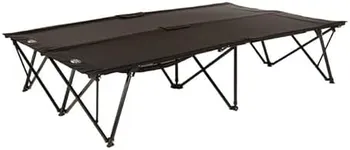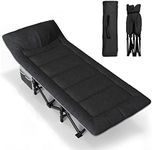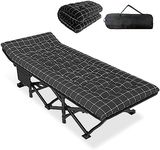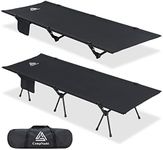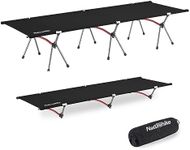Buying Guide for the Best Camping Cots
Choosing the right camping cot can make a big difference in your comfort and quality of sleep while outdoors. The best cot for you depends on your camping style, how much you value comfort versus portability, and the conditions you expect to encounter. Before making a decision, think about how you’ll use the cot—whether it’s for car camping, backpacking, or as a guest bed at home. Consider your personal preferences for sleeping surface, ease of setup, and how much space you have in your tent or vehicle.Weight CapacityWeight capacity refers to the maximum amount of weight the cot can safely support. This is important because exceeding the limit can damage the cot or cause it to collapse. Cots typically range from supporting around 200 pounds to over 400 pounds. If you’re a lighter person or the cot is for a child, a lower capacity may be fine. For heavier adults or if you want extra durability, look for higher weight limits. Always choose a cot with a capacity that comfortably exceeds your body weight for safety and longevity.
Size (Length and Width)The size of a camping cot determines how much sleeping space you have. Standard cots are usually around 75 inches long and 25 inches wide, but there are longer and wider options for taller or larger individuals. If you’re tall or like to move around in your sleep, look for a cot labeled as 'XL' or 'long.' For smaller tents or children, a compact cot may be better. Measure your tent and consider your body size to pick a cot that fits both you and your shelter comfortably.
Weight of the CotThe weight of the cot affects how easy it is to carry and transport. Lightweight cots (under 5 pounds) are best for backpacking or situations where you need to carry your gear over long distances. Heavier cots (10 pounds or more) are usually sturdier and more comfortable, making them ideal for car camping or use at home. Think about how far you’ll need to carry the cot and how much weight you’re willing to add to your gear.
Setup and PackabilitySetup and packability refer to how easy it is to assemble and disassemble the cot, as well as how small it packs down for storage. Some cots have simple folding designs that set up in seconds, while others require more assembly. If you want convenience and quick setup, look for cots with fewer parts and intuitive designs. For backpacking, choose a cot that packs down small and fits easily in your pack. If you’re car camping, a larger packed size may not be an issue.
Comfort FeaturesComfort features include things like padding, fabric type, and support structure. Some cots have built-in padding or use softer materials for extra comfort, while others are more basic. The support structure (such as the number and type of legs) also affects how stable and comfortable the cot feels. If you’re a light sleeper or value a plush surface, look for cots with added comfort features. If you’re fine with a firmer surface or plan to use a sleeping pad, a simpler cot may suffice.
Height Off the GroundThe height of the cot determines how far you are from the ground when sleeping. Higher cots (15 inches or more) make it easier to get in and out of bed and provide more storage space underneath. Lower cots (less than 10 inches) are lighter and fit better in smaller tents. If you have mobility issues or want extra storage, a higher cot is a good choice. For low-profile tents or if you want to save weight, a lower cot may be better.
Durability and MaterialsDurability depends on the materials used for the frame and fabric. Aluminum frames are lightweight and rust-resistant, while steel frames are heavier but often more robust. The fabric should be strong and tear-resistant, such as polyester or nylon. If you plan to use the cot frequently or in rough conditions, prioritize durable materials. For occasional use or indoor settings, lighter materials may be sufficient.

